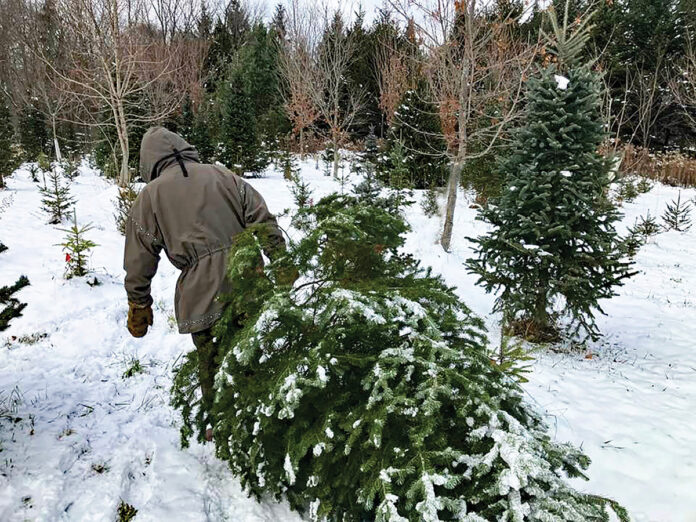
Shortly after Thanksgiving, I shared some photos of my husband at the tree farm, dragging our freshly cut Christmas tree through the snow. A friend told me it reminded her of a scene right out of Currier and Ives. I had to agree. There is something so rewarding about cutting your own tree. The thorough search through rows and rows of evergreens, the scrutinization of which tree has the most handsome shape, the biting cold that eventually creeps into your fingers and toes, the effort of cutting and dragging it back to the vehicle and don’t forget the smell — oh the sweet smell!
We haven’t had much snow this year, but by gosh, it snowed the day before we went to get our tree and melted the day after. How fortuitous was that?
Live v. artificial

There is much debate over hosting a live versus an artificial tree. Artificial is safer, less of a fire hazard. The same tree can be utilized year after year. Some feel that by using an artificial tree, they are saving the life of a real one. The fact is, most Christmas trees are grown on farms, much like crops, for the purpose of being harvested. When these trees are cut down, new ones are replanted yearly in their place. Actually, very few evergreens are removed from federal forests, an activity that is closely regulated by the U.S. Forest Service. Real trees are biodegradable, making them more sustainable. Sadly, artificial trees can take hundreds of years to decompose when placed in landfills.
I’m not here to tell you which kind you should have. If you can’t decide, you can always have one of each. My 95-year-old mom still has a live tree in her family room and an artificial one her living room, a tradition that I have known since as long as I can remember.
Repurposing your tree

Probably the best argument for having a live tree, is that there are so many ways that it can be repurposed after Christmas. Start by calling your local park or soil and water conservation district. These organizations often have conservation projects underway and can use the trees to aid in their work. Christmas trees can be used in stream revetment operations to rehabilitate or stabilize banks. They can also be dragged out onto lake/pond ice. Heavy cinder blocks or rocks tied to the trunks will help them to sink to the bottom as the ice melts, creating important fish habitat. Think about contacting your local township to see if they are collecting trees to turn into mulch.
If you offer seed to the birds, consider placing your spent tree near the feeding area. Whether you secure it to something, allowing it to remain in a vertical position, or leave it on its side, the dense foliage will provide quick cover for your birds when danger such as a hungry Cooper’s hawk shows up on the scene. When nasty winter weather hits, you will see your birds utilizing the thick branches to protect themselves from the elements and stay warm. You can also redecorate your tree using a variety of feeders. Hang a suet feeder, decorate with strands of plain Cheerios and cranberries, or better yet, cut a section of the tree’s trunk, drill some holes, and fill it with peanut butter, creating a new feeder. If you decorate your Christmas tree with tinsel, make sure that all the strands are removed before placing it outside, as animals may try to eat it, causing internal damage.
I like to clip off some of the branches of my tree to use as a form of mulch in my garden. Placing them in raised beds containing asparagus or garlic will help protect the roots of these plants as winter takes hold. They also provide shelter for the pollinators, and the needles help build the soil as they break down. It is actually a myth that pine needles turn the soil more acidic. Yes, the needles are acidic when they initially drop from the trees, but in this capacity, they don’t have much ability to lower the pH, as they become neutralized when decomposed.
If you have an artsy streak, you can certainly find ways to recycle your tree. One of the most popular ways is to remove all the branches and cut up the trunk into thin slices. These slices, when dried, can be made into handsome sets of coasters or used as woodburning projects for ornaments. Recognizing my love of butterflies and moths, a dear friend surprised me with a beautiful Cecropia moth she had burned into a similar slice of wood for my tree this year. Thus, the wood from another Christmas tree now adorns my own.
It wouldn’t be Christmas for my alpine goat without a few branches on which to munch. Yep, goats love evergreens and it is a satisfying sight to watch my doe munching away on this winter treat.
In the end, when I have utilized my tree in every possible way, there is just one thing left to do. I add it to an ever-growing brush pile in the woods next to my house. Brush piles, now known as habitat piles, are incredibly important to wildlife. Made up of leaves, sticks, branches, Christmas trees, they offer places for an overwhelming number of wildlife species to nest, rest and permanently reside.
Suffice it to say, over the years I have come to realize that purchasing a live tree is one of the best Christmas presents I can get myself!











